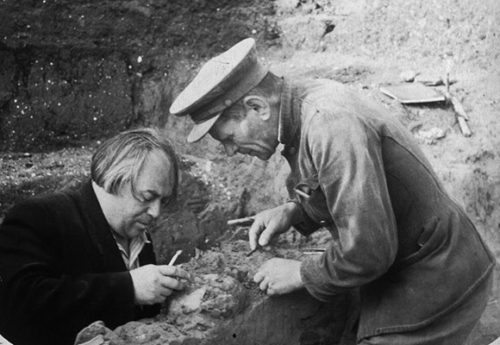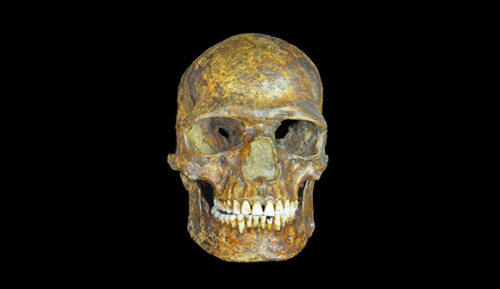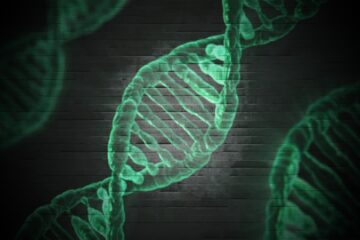Groundbreaking Study of Ancient DNA Reveals Genetic Commonality to Modern Europeans
GROUNDBREAKING genetic analysis of a 37,000-year-old human bone from Russia has revealed that modern Europeans have remained genetically identical from that time onward—and that there are increasing numbers of holes in the “out-of-Africa” theory of human development. (ILLUSTRATION: Kostenki 14. Image from the Peter the Great Museum of Anthropology and Ethnography.)
The DNA analysis, published in a recent issue of the journal Science (“Genomic structure in Europeans dating back at least 36,200 years”, Science, DOI: 10.1126), looked at a genome sequence from a Russian man known as “Kostenki 14” (or K14 for short), found at Kostenki-Borshchevo, north of the Black Sea.
The remains date from 38,700 to 36,200 years ago, and are one of the oldest fossils of anatomically modern humans from anywhere in Europe.
According to the study’s synopsis, the analysis revealed that “K14 shares a close ancestry with the 24,000-year-old Mal’ta boy from central Siberia, European Mesolithic hunter-gatherers, some contemporary western Siberians, and many Europeans, but not eastern Asians.”
Furthermore, the study found, the K14 genome “shows evidence of shared ancestry with a population basal to all Eurasians that also relates to later European Neolithic farmers.”
Significantly, K14’s genes include signature traces of DNA long thought to have been part of separate movements into Europe, Eske Willerslev, a geneticist at the University of Copenhagen and co-author of the study, said in a media interview.
“One of the surprising things is that if you go 37,000 years back in time, you find all the major genetic components that are present in modern Europeans,” Willerslev added.
This means that Europe’s past is actually a single genetic whole, even if it was created by a continuous flow over millennia. This discovery is bound to cause consternation among those who quite falsely argue that European history has always been “mixed,” racially-speaking.

Traditionally, historians have believed that there were groups of hunter-gatherers, “moving from Africa into Europe beginning about 40,000 years ago.”
Much later, they suggested, a separate group of farmers and herders left the Middle East and made their way north, eventually out-competing the hunter-gatherer locals and forming the basis for the modern European genome. It was the introduction of agriculture by this second wave of people—the so-called Neolithic Revolution—which was such a pivotal moment in prehistory.
While there is no question that there was a cultural shift from hunter-gatherer to agricultural, the new DNA evidence from K14 suggests that the bearers of this culture were one and the same people.
“You wouldn’t predict if you go back to one of our earliest individuals, all the components of modern Europeans were already there,” Willerslev added.
Genes once thought to have arrived with the first farmers, for instance, now seem to have been around much earlier.
Instead of separate groups colliding and occasionally mingling, Willerslev said it seemed that there was actually a single, genetically similar population sprawling across the continent, from Russia to the Middle East to northern Europe.
“Rather than separate populations moving into each others’ areas and having sex with each other,” he says, “there was a single ‘meta-population’ having sex—or exchanging genes—in a complex and heterogeneous way.”
Furthermore, Kostenki man’s DNA shows that he was unrelated to East Asians or Australo-Melanesians—which is highly problematic for the “diverging out of Africa” theory, which would have implied that these racial groups only diverged after “leaving Africa” rather than before, as the theory has always postulated.







Does this mean that all European people are pretty much the same genetically despite the fact that there are so many different European nationalities? I’m sure there are some minor genetic variations between the different European nationalities, but I wonder if these differences are significant enough to classify different sub-species of Europeans. I’m not talking about European people who have intermingled their gene pools with non-whites, like people from the Iberian peninsula, Southern Italians, and South Eastern Europeans. I think it would be quite a revelation if we were to think of all the different European nationalities as more or less equal. This would lead to much less petty nationalism and jingoism.
Here’s a chart showing genetic similarities between different nationalities and subraces worldwide. Bear in kind that similarity does not necessarily imply recent mixture, and may simply mean divergence from a common sub-racial or racial ancestor happened more recently in some areas than others. http://flawlesslogic.com/racial-similarity-2014.png Remembering this as we look at the chart, we can now clearly see that the most uniquely European Europeans are the Basques. The Nordics (and I am of 100 per cent. Norwegian ancestry as far as is known) are somewhat less so. The chart below from Cavalli-Sforza, which I’ve used in my radio program, is a genetic distance chart, which shows each major racial grouping in its own quadrant, clearly evolving away from all the others, and with the center, or average, position on the chart… Read more »
Thanks for the comment and the charts Kevin. I am quite surprised that the Nordics, including Norwegians, are not the “most European” of the European. I was under the impression that Scandinavian peoples were of the best racial stock of Europe. I’m not sure who the Basques are though to tell you the truth. Also I agree with your second statement and graph that suggests that the different racial groups evolved far away from each other. and in different quadrants so to speak. I highly doubt that all humanity originated from a singular location, and I doubt even more that that location was in Africa. I don’t know how evolution occurred, but to me it’s clear that the process took place for different species of man independently of each other,… Read more »
Well, I’d like to think my fellow Scandinavians are “the “best racial stock,” and maybe we are, but am forced to admit that that’s an opinion and not a fact. At any rate, “best” and “most uniquely European” might not be the same thing, no matter how much we wish they were. And, in every subrace of Europe, evolution and devolution are constantly occurring, improving or degrading its evolutionary grade depending on social policies. Lately, dysgenic breeding seems to to the rule, unfortunately. I am not one of those who emphasizes petty nationalism or subracialism. Take 1,000 Norwegians and 1,000 Corsicans and forbid them to speak or wear distinctive clothing, and you’d make mistakes in classification a good deal of the time. However, the coming dark times are going to… Read more »
I guess the way you place value to a race is subjective. Subjectively speaking though, I think the Scandinavians are probably the most aesthetically pleasing members of the European race. Scandinavian Women are by far the prettiest in the world. This is due to their Nordic features (Blond hair, blue eyes), and also their attractive bodies. I don’t think this is only my opinion, I believe there were studies conducted in which males from all different races chose Scandinavian women as being the most desirable women in the world. But I suppose if you were to use other factors to gauge the quality of a nationality, you would probably look at their cultural achievements, in terms of art, technology, and also their level of world dominance. For instance the German… Read more »